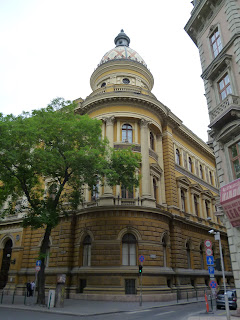
Budapest had a very difficult 20th Century, having survived 2 world wars, and Soviet occupation. A lot of the buildings are glimmers of the treasures they once were, but since the end of the Soviet era, Budapest has had a tremendous influx of investment, and everywhere, buildings are rediscovering themselves, and being restored to their former grandeur.

Everywhere, you can see buildings which still show the conditions the city had to endure, and buildings that have been resurrected. This square in particular with its twin buildings is a great example.
Some buildings are a blending of Art Nouveau and traditional Hungarian folk art in an attempt to create a style unique to the culture.
Sadly, some of Budapest best architectural jewelboxes are closed and lonely places, just dying to have something done with them, but as landmarks, the cost to renovate and redevelop is very expensive.
This former shopping mall in the heart of Budapest is a great example. Stunning, but closed and empty. . .
In certain cases, these older buildings were modified and updated in the Soviet tradition of equality. The bottom floors were stripped of their distinctiveness and modernized with a black granite covering. Sadly, it makes many streets equally drab. And no, the Hungarians didn't see this as an improvement to their city.
Where buildings have been restored, they are beautiful.
It's almost like Paris without the pretense.
Very European and cosmopolitan.
Budapest even has its own Opera House. It was built during the Hapsburg dynasty and built using some money from Franz Ferdinand I. His one stipulation was that it couldn't be larger than his Opera House in Vienna. He didn't say anything about it being prettier.
Sadly some buildings are still waiting to be restored. Even on the main boulevard.
It's only a matter of time and money. . .

















No comments:
Post a Comment